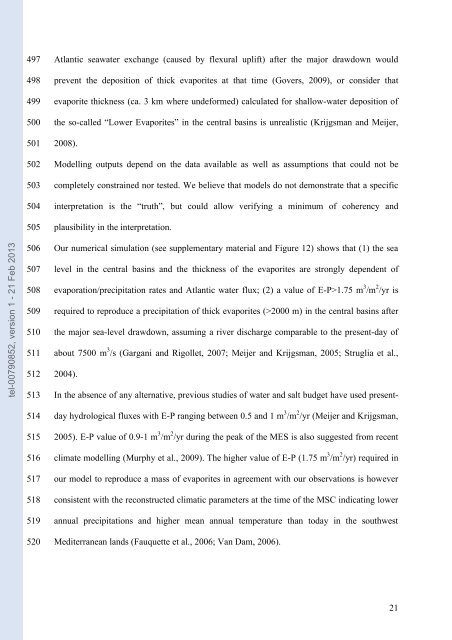Quantification des flux sédimentaires et de la subsidence du bassin ...
Quantification des flux sédimentaires et de la subsidence du bassin ...
Quantification des flux sédimentaires et de la subsidence du bassin ...
Create successful ePaper yourself
Turn your PDF publications into a flip-book with our unique Google optimized e-Paper software.
tel-00790852, version 1 - 21 Feb 2013<br />
497<br />
498<br />
499<br />
500<br />
501<br />
502<br />
503<br />
504<br />
505<br />
506<br />
507<br />
508<br />
509<br />
510<br />
511<br />
512<br />
513<br />
514<br />
515<br />
516<br />
517<br />
518<br />
519<br />
520<br />
At<strong>la</strong>ntic seawater exchange (caused by flexural uplift) after the major drawdown would<br />
prevent the <strong>de</strong>position of thick evaporites at that time (Govers, 2009), or consi<strong>de</strong>r that<br />
evaporite thickness (ca. 3 km where un<strong>de</strong>formed) calcu<strong>la</strong>ted for shallow-water <strong>de</strong>position of<br />
the so-called “Lower Evaporites” in the central basins is unrealistic (Krijgsman and Meijer,<br />
2008).<br />
Mo<strong>de</strong>lling outputs <strong>de</strong>pend on the data avai<strong>la</strong>ble as well as assumptions that could not be<br />
compl<strong>et</strong>ely constrained nor tested. We believe that mo<strong>de</strong>ls do not <strong>de</strong>monstrate that a specific<br />
interpr<strong>et</strong>ation is the “truth”, but could allow verifying a minimum of coherency and<br />
p<strong>la</strong>usibility in the interpr<strong>et</strong>ation.<br />
Our numerical simu<strong>la</strong>tion (see supplementary material and Figure 12) shows that (1) the sea<br />
level in the central basins and the thickness of the evaporites are strongly <strong>de</strong>pen<strong>de</strong>nt of<br />
evaporation/precipitation rates and At<strong>la</strong>ntic water <strong>flux</strong>; (2) a value of E-P>1.75 m 3 /m 2 /yr is<br />
required to repro<strong>du</strong>ce a precipitation of thick evaporites (>2000 m) in the central basins after<br />
the major sea-level drawdown, assuming a river discharge comparable to the present-day of<br />
about 7500 m 3 /s (Gargani and Rigoll<strong>et</strong>, 2007; Meijer and Krijgsman, 2005; Struglia <strong>et</strong> al.,<br />
2004).<br />
In the absence of any alternative, previous studies of water and salt budg<strong>et</strong> have used present-<br />
day hydrological <strong>flux</strong>es with E-P ranging b<strong>et</strong>ween 0.5 and 1 m 3 /m 2 /yr (Meijer and Krijgsman,<br />
2005). E-P value of 0.9-1 m 3 /m 2 /yr <strong>du</strong>ring the peak of the MES is also suggested from recent<br />
climate mo<strong>de</strong>lling (Murphy <strong>et</strong> al., 2009). The higher value of E-P (1.75 m 3 /m 2 /yr) required in<br />
our mo<strong>de</strong>l to repro<strong>du</strong>ce a mass of evaporites in agreement with our observations is however<br />
consistent with the reconstructed climatic param<strong>et</strong>ers at the time of the MSC indicating lower<br />
annual precipitations and higher mean annual temperature than today in the southwest<br />
Mediterranean <strong>la</strong>nds (Fauqu<strong>et</strong>te <strong>et</strong> al., 2006; Van Dam, 2006).<br />
21

















